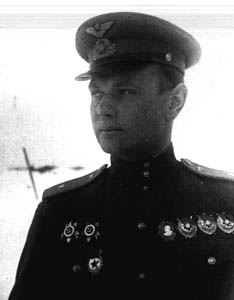Soviet Union

Polkovnink Anatoliy Vasilyevich Kislyakov HSU
Soviet Union

Polkovnink Anatoliy Vasilyevich Kislyakov HSU

20 February 1918 – 28 July 1998
Kislyakov was born in the Moscow area on 20 February 1918 and entered military service at age 21.
He was graduated as a pilot at Borisoglebsk military flying school a year later and was posted to the 153 IAP.
Kislyakov scored for the first time on 4 August 1941.
He was appointed deputy commander of the regiment and deployed with it to the Stalingrad area.
On 6 August 1942, kapitan Sergey Mironov, starshiy leitenant Mikhail Ivanov and leitenant Kislyakov claimed a shared MC.200 over Podkletnoye together with a fourth pilot.
The 153 IAP became a Guards unit when it was renamed to the 28 GIAP on 22 November 1942.
At 12:52 (10:52 German time) on 30 December 1942, six Airacobras from 28 GIAP took off to escort a Tu-2 reconnaissance aircraft toward the Ramushevo corridor. However, the Airacobras had not even climbed to the assigned altitude above their own airfield when they spotted five Bf 109. General-major Fyodor Polynin, 6 VA’s deputy command tells the story from the Soviet perspective:
“Apparently these Germans had not noticed the Soviet fighters, but our top cover immediately discovered them. ‘Messers from behind!’ Starshiy leitenant Vladimir Bezrodnyy called out over the radio.”The Airacobra pilots were no newbies. The formation leader, the deputy regimental commander kapitan Kislyakov, had fought with the regiment since the outbreak of the war, and Bezrodnyy had three on his tally However, on this occasion Kislyakov got so excited that he forgot his main task (to escort the Tu-2) and ordered an attack first-line.
“He gave a short burst, and one of the enemy aircraft went down in flames. Manoeuvring skilfully, Kislyakov got on to the tail of another enemy fighter. He opened fire from a distance of 50-70 meters. The Messer began to emit a trail of thick smoke, turned and attempted to escape. However, Kislyakov would not let his prey flee. He overtook him over the town of Valday, but when he saw that the German had lowered the landing gear and was about to land on the frozen surface of the lake, he held his fire. After all, this enemy will also be counted as shot down as he lands in our territory. All the same, he will be taken prisoner.In fact, it seems that mladshiy leitenant Pas’ko was credited with one Bf 109 north-east of Valday as his first victory while serzhant Lorents was credited with one over Lake Somino (i.e. it seems that this is the one mentioned by Polynin) as his third victory. Thus 28 GIAP claimed five Bf 109s in this combat.
While Kislyakov fought with leading pair, mladshiy leitenant Nikolay Pas’ko and serzhant Rostislav Lorents also shot down one enemy fighter. It went down on the ice of the same lake, near Valday. The soldiers came to their rescue and captured all three Fascist pilots.”
“What his comrades [. . .] had seen was only the cockpit canopy that he had jettisoned in order to bail out with the parachute. [. . .] The cabin roof flying through the air resembles someone who is falling, knees pulled up to the chest in a squatting position.”Koppelberg had served as a fighter pilot since 1938. Bruhn had been in action since 1940 and had been credited with seven victories. Asking to meet his victor, Bruhn was introduced to Kislyakov the next day, who described this encounter:
“The appearance of a simple Russian guy obviously did not appeal to Bruhn. Even so, he seemed to feel more reassured when I told him that I already had eleven German planes on my account.”However, the hot-headed Kislyakov had failed in his escort mission. He was lucky that the Tu-2 escaped the attention of the German fighters and returned safely to base after accomplishing its mission, but 6 VA’s C.O., General-major Kondratyuk, ordered the Diviziya commander, podpolkovnik Georgiy Ivanov, to punish all the participating Soviet pilots. However, the Deputy Commander of the Political Department of 6 VA, polkovnik Andrey Vyvolokin, convinced him to make use of the propaganda effect of the shooting down and capturing of these three JG 54 pilots. The ”punishment” took the form of an order to the six Airacobra pilots to write an article for the papers about the event. ”That will be the most severe punishment”, Vyvolokin said jokingly: ”We all know what pilots think of writing”. The article, which appeared in Sokol Rodinyy (Falcons of the Motherland), read:
“The translator calls them in turn: Grothoff Paul, Emil Koppelberg, Bruhn Heinrich. And in turn each one is asked the question: ‘How were you shot down?’ – ‘Obviously, he came up on my tail so quickly that my experience didn't help me. He was, apparently, a good shot – he knocked me down with the first burst. I can’t say anything more, because I woke up only at the transit point for prisoners.’
Feldwebel Emil Koppelberg replied: ‘I saw the Soviet fighter. He attacked me when I was leaving the anti-aircraft zone, and when I noticed it was too late. Outmanoeuvred, I went down. Considering that I have more than five thousand hours in the air, it is obvious that it took a great Soviet ace to shoot me down.’
Only non-commissioned officer Heinrich Bruhn was able to fight back against Kislyakov: ‘I thought that I had him, but although I attacked him twice, I was shot down. That means that the Soviet pilot must have excelled in his combat and flight skills. Before that, I had participated in more than 70 air combats.’
These are not newbies, but grey-haired jackals! The youngest of them, Grothoff, has 800 flight hours. Admitting to the superiority of the Soviet pilots they have to grit their teeth: they were shot down by such young pilots. The interpreter asked Feldwebel Koppelberg: ‘Was it long ago since you arrived at the Eastern Front?’ – ‘I arrived at the airfield on December 29, and on December 30 I was shot down’. Koppelberg has been flying since 1935 and has been fighting since September 1939. English pilots in Holland broke his skull. His fingers were damaged. He spent a long time in hospital, and then was on a long-term furlough. After recovering from his injuries, he flew transport planes. Then he was made an instructor at a flight school, and now he was sent again to the frontline.”
28 GIAP fought with FW 190s in the Sol’tsy area on 24 May 1943. Kislyakov claimed one destroyed west of the town while Nikolay Pas’ko claimed a second destroyed north of the town.
Four pilots from 28 GIAP, claimed a shared Ju 88 over Zhuravy on 7 October 1943. Pilots included Kislyakov and Fedor Mazurin.
On 17 October 1944, the Airacobras from 28 GIAP was in combat with Bf 109s near Vilkavishkis. Kislyakov claimed one destroyed south-east of Vilkavishkis while Mikhail Nasonov claimed one destroyed south-west of Vilkavishkis.
Kislyakov flew his last sorties over East Prussia in 1945.
He was decorated with the Gold Star of Hero of the Soviet Union and the Order of Lenin on 18 August 1945.
Kislyakov was also decorated with the Orders of Lenin (twice), the Red Banner (thrice), the Patriotic War 1st Class (twice), the Patriotic War 2nd Class and the Red Star (twice).
Kislyakov ended the war with 1 biplane victory and a total of 14. These were claimed on 539 sorties.
He also claimed an observation balloon during the war.
He remained in the ranks following World War II and graduated from the Air Force Academy in 1952. He concluded his active duty with the rank of polkovnik in 1968.
Kislyakov passed away on 28 July 1998.
Claims:
| Kill no. | Date | Time | Number | Type | Result | Plane type | Serial no. | Locality | Unit |
| 1941 | |||||||||
| 1 | 04/08/41 | 1 | Fokker D.XXI | Destroyed | I-153 | NW Reuskyula Station | 153 IAP | ||
| 1942 | |||||||||
| 2 | 30/06/42 | 1 | Ju 88 | Destroyed | Airacobra | Matveyevka | 153 IAP | ||
| 3 | 10/07/42 | 1 | Bf 109 | Destroyed | Airacobra | N outskirts Voronezh | 153 IAP | ||
| 4 | 23/07/42 | 1 | Bf 109 | Destroyed | Airacobra | S Bol'shaya Vereyka | 153 IAP | ||
| 06/08/42 | 1/4 | MC.200 | Shared destroyed | Airacobra | Podkletnoye | 153 IAP | |||
| 5 | 30/12/42 | 12:52- | 1 | Bf 109 (a) | Destroyed | Airacobra | SW Valday | 28 GIAP | |
| 6 | 30/12/42 | 12:52- | 1 | Bf 109 (a) | Destroyed | Airacobra | SW Valday | 28 GIAP | |
| 1943 | |||||||||
| 7 | 05/05/43 | 1 | FW 190 | Destroyed | Airacobra | W Vzvod | 28 GIAP | ||
| 8 | 24/05/43 | 1 | FW 190 | Destroyed | Airacobra | W Sol'tsy | 28 GIAP | ||
| 30/07/43 | 1 | Balloon | Destroyed | Airacobra | Sonakovschina | 28 GIAP | |||
| 07/10/43 | 1/4 | Ju 88 | Shared destroyed | Airacobra | Zhuravy | 28 GIAP | |||
| 9 | 10/10/43 | 1 | FW 190 | Destroyed | Airacobra | Degtevo | 28 GIAP | ||
| 10 | 11/10/43 | 1 | Ju 87 | Destroyed | Airacobra | NW Nevel | 28 GIAP | ||
| 11 | 11/10/43 | 1 | FW 190 | Destroyed | Airacobra | E Gorodok | 28 GIAP | ||
| 12 | 11/11/43 | 1 | FW 189 (b) | Destroyed | Airacobra | Suzhokhi | 28 GIAP | ||
| 1944 | |||||||||
| 13 | 17/09/44 | 1 | FW 190 | Destroyed | Airacobra | Adeultse Station | 28 GIAP | ||
| 14 | 17/10/44 | 1 | Bf 109 | Destroyed | Airacobra | SE Vilkavishkis | 28 GIAP |
Biplane victories: 1 destroyed.
TOTAL: 14 and 2 shared destroyed, 1 observation balloon.
(a) Claimed in combat with I. and II./JG 54, which lost 3 Bf 109 G-2s (3 pilots PoW). 28 GIAP claimed 5 Bf 109 without losses
(b) Not verified with Luftwaffe records.
Sources:
All aces of Stalin 1936–1953 – Mikhail Bykov, 2014
Black Cross/Red Star Volume 4 Stalingrad to Kuban - Christer Bergström, 2019 Vaktel Förlag, Eskistuna, ISBN 978-91-88441-21-8
Deutsche Luftwaffe Losses & Claims -series - Michael Balss
Soviet Aces 1936-1953
Soviet Fighter Pilots 1936-1953 - Mikhail Bykov
Stalin's Eagles - Hans D. Seidl, 1998 Schiffer Publishing, ISBN 0-7643-0476-3
Additional information kindly provided by Tuomo Lukkari and Ondrej Repka.


